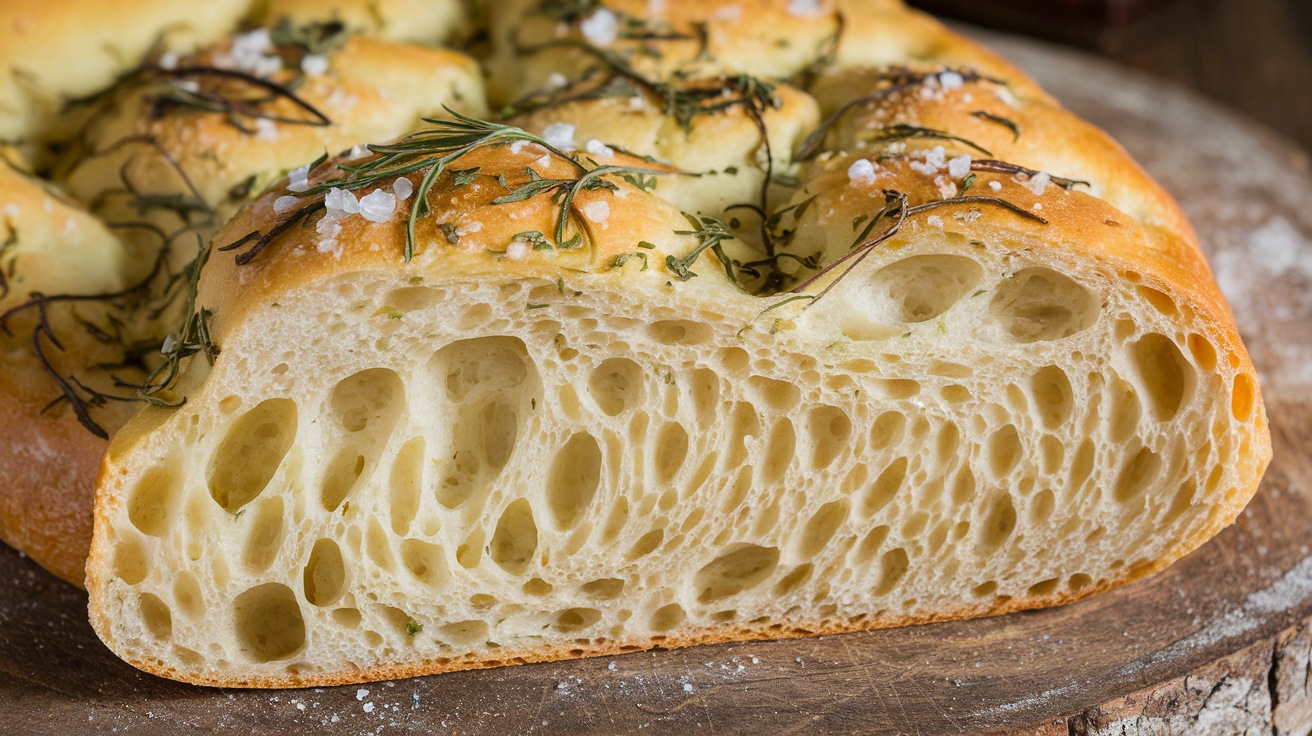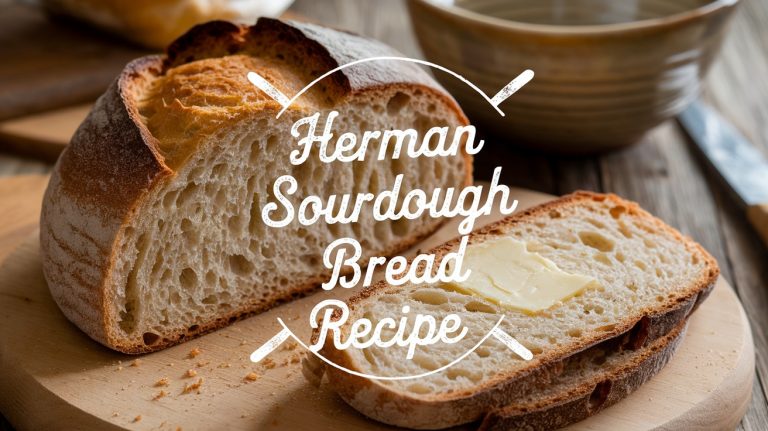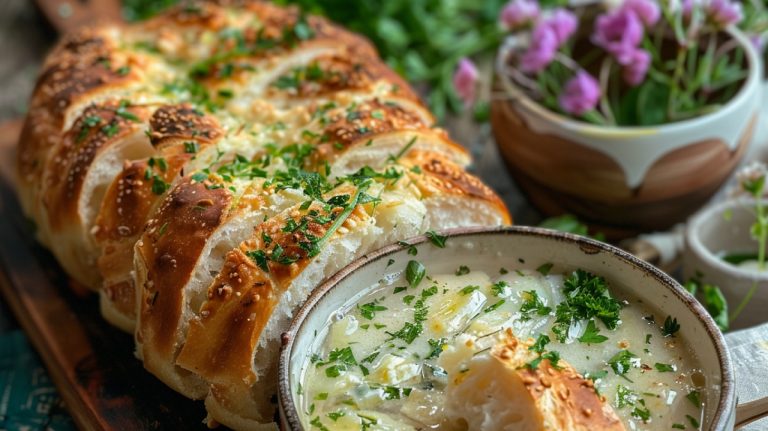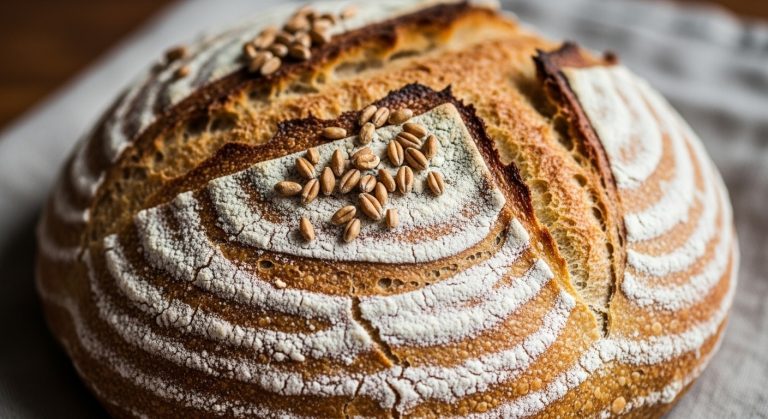Herbed Focaccia Recipe: Golden, Crispy and Deliciously Healthy
You’re about to create an irresistible herbed focaccia, a soft and airy Italian flatbread. Start by activating 2 teaspoons of active dry yeast in 2 cups of warm water.
Mix in 1/4 cup of herb-infused olive oil and salt, then gradually add 4.5 to 5 cups of all-purpose flour until the dough forms. Knead for about 5 minutes, then let it rise for 2–3 hours.
Finally, top it with fresh rosemary or your favorite herbs before baking until golden brown. This focaccia is perfect alongside soups or as a sandwich base, and there’s so much more to explore.
Key Takeaways
- Combine 2 cups of warm water, sugar, and 2 teaspoons of active dry yeast, letting it froth before mixing with olive oil and flour.
- Gradually incorporate 4.5 to 5 cups of all-purpose flour to create a soft dough, kneading for about 5 minutes.
- Allow the dough to rise in a greased bowl, covered, for 2-3 hours until it doubles in size.
- Before baking, drizzle with 5 tablespoons of herb olive oil and top with fresh rosemary or other herbs to enhance flavor.
- Bake until golden crust forms, serving alongside soups or transforming into sandwiches or pizza bases.
Essential Ingredients

To create a delicious herbed focaccia, you’ll need a handful of essential ingredients that come together to produce a delectable bread. These components not only form the base of your focaccia but also infuse it with rich flavors and textures.
The combination of warm, herb-infused focaccia with various toppings makes it an enticing centerpiece for any gathering, as seen in the Focaccia Bread Charcuterie Board.
- 4.5 to 5 cups of all-purpose flour for structure
- 2 teaspoons of active dry yeast to help the dough rise
- 2 cups of warm water (between 100-110°F) to activate the yeast
- 1/4 cup of herb olive oil for the dough, plus 5 tablespoons for topping
- Fresh rosemary and other herbs for that aromatic touch
The all-purpose flour provides the backbone of your focaccia, ensuring it bakes into a golden brown delight.
Active dry yeast combined with a bit of sugar creates the perfect environment for the dough to rise. Mix in warm water and watch the magic happen.
You can infuse olive oil into your dough; it adds moisture and flavor, while coarse salt and seasonings enhance every bite.
Preparation Steps
With your ingredients ready, it’s time to combine them to create that delicious herbed focaccia. Start by whisking together half of the warm water, sugar, and yeast. Allow it to rest for 5 minutes until frothy—this shows that the yeast is active.
As you prepare, consider the benefits of using a mix of all-purpose and whole wheat flour for added flavor and texture, similar to sourdough focaccia pizza. Next, combine the yeast mixture with olive oil, salt, and 1 cup of flour in a mixing bowl. Mix for 20 seconds before gradually adding an additional 3.5 cups of flour, beating for 2 minutes until well combined.
Now, knead the dough for about 5 minutes until it’s soft and slightly tacky. Perform the windowpane test to verify proper gluten development. Once your dough is ready, place it in a greased bowl and cover the bowl with a damp cloth. Allow it to rest for 2 to 3 hours until it doubles in size, enhancing flavor and texture.
After the initial rise, stretch the dough into an oiled baking pan. You can cover the pan and refrigerate overnight, which deepens the flavor.
Storage and Freezing
You might wonder how to keep the leftovers fresh once you’ve savored every last bite of your herbed focaccia. Thanks to its high olive oil content, leftover focaccia can be stored at room temperature in a zip-top bag for 4-5 days.
To preserve its delightful flavor and texture even longer, consider the benefits of freezing sourdough bread, which can lock in freshness and enhance health benefits. If you want to extend its life, consider these storage options:
- Wrap it tightly in plastic wrap.
- Place the wrapped focaccia inside a zip-top bag.
- Store in the refrigerator in an airtight container for up to a week.
- For long-term storage, freeze it, allowing it to last for up to 3 months.
- Coat dough with olive oil before sealing it in a bag for future baking.
When you’re ready to enjoy that frozen focaccia, simply let it thaw at room temperature or warm it in the oven for the best texture.
Serving Suggestions
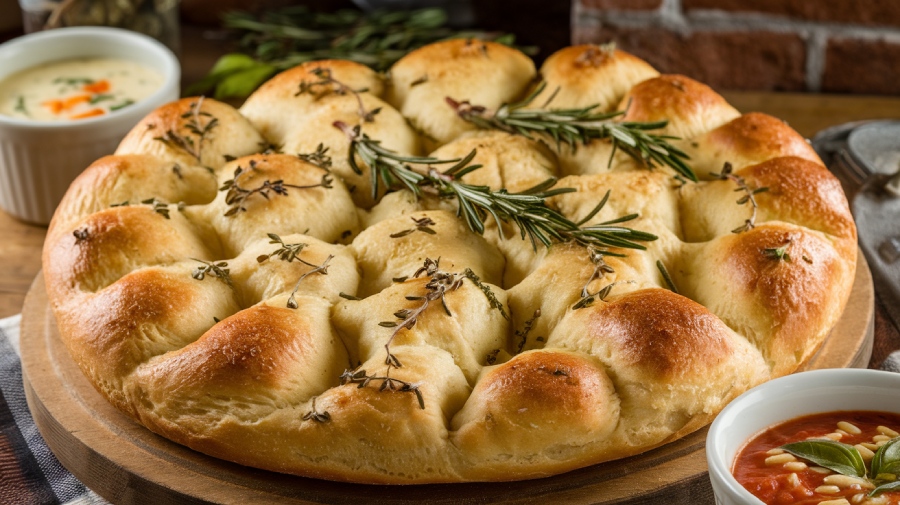
Herbed focaccia isn’t just a delightful treat on its own; it also serves as a versatile canvas for a variety of delicious pairings. You can serve it alongside creamy vegetable soups or rich tomato-based soups like Tomato Basil Orzo, enhancing your meal with its flavorful presence.
For an aromatic twist, consider pairing it with a garlic dipping oil that complements the herbed flavors beautifully. If you’re in the mood for something heartier, consider transforming your focaccia into a sandwich base for tuna salad or egg salad, offering a tasty alternative to traditional bread.
For a fun twist, top your focaccia with your favorite pizza toppings and bake it for a quick meal that’s sure to please everyone. Dipping your focaccia in a mixture of balsamic vinegar and olive oil creates a simple yet delightful appetizer, perfect for entertaining guests or enjoying a cozy night in.
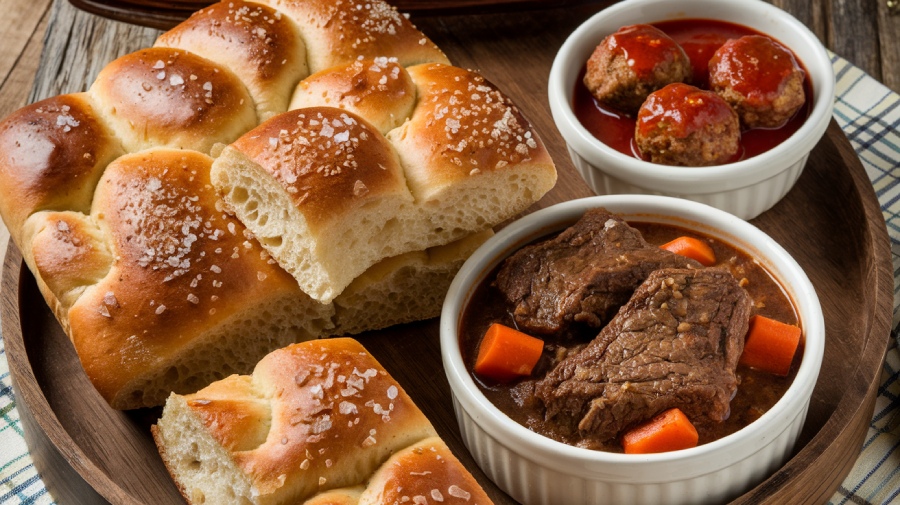
If you want a substantial dining experience, serve focaccia alongside hearty dishes like Irish Beef Stew or Italian meatballs. This complements the meal and adds a comforting element to your table.
Frequently Asked Questions
What Are the Two Types of Focaccia?
When you explore focaccia, you’ll discover two main types: Focaccia al Rosmarino and Focaccia Genovese.
Focaccia al Rosmarino boasts a simple, herby flavor with fresh rosemary and coarse salt, perfect as a side dish.
In contrast, Focaccia Genovese features a thicker, spongy texture, often drizzled with olive oil and salt, making it ideal for sandwiches.
Each type reflects its unique regional heritage, inviting you to savor the diverse tastes of Italy.
What Is the Best Flour for Focaccia Bread?
So, you think any flour will do, huh? Not quite! The best flour for focaccia is bread flour, thanks to its higher protein content that gives you that delightful chewiness.
Sure, you can use all-purpose flour, but don’t expect the same airy texture. Mixing both can give you a nice balance.
And remember, always go for unbleached flour to keep those nutrients intact. Your focaccia deserves the best, after all!
How Do You Keep Rosemary From Burning on Focaccia?
To keep rosemary from burning on focaccia, add it during the last 5-10 minutes of baking.
Using fresh rosemary is a great option since it has more moisture and burns less. Lightly coat the rosemary in olive oil before adding it to the dough to provide some protection from direct heat.
Opt for larger sprigs instead of finely chopped pieces, and keep an eye on your focaccia to prevent over-browning.
Why Don’t You Knead Focaccia?
You don’t knead focaccia because its high hydration dough requires a gentler approach. Instead of traditional kneading, you mix the ingredients just until combined and let it rest.
This resting period fosters gluten development naturally. By folding the dough during rising, you incorporate air, creating that light, airy texture without overworking it.
A longer proofing time enhances flavor and strength, making kneading completely unnecessary for this delicious bread.
Share the Joy: Focaccia That Brings Family and Friends Together
Now that you’ve mastered the art of herbed focaccia, remember: “Good things come to those who bake.” Enjoy the fragrant aroma wafting through your kitchen as you slice into that golden, crispy crust.
Whether served warm with olive oil or topped with your favorite ingredients, this bread is sure to impress. So gather your friends and family, share your creation, and relish in the joy of homemade goodness that brings everyone together.

